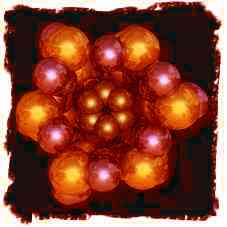Molecular
dynamics in Nanoporous Crystals
In
thiourea organic intergrowth crystals (also called inclusion
compounds), thiourea molecules, by means of an extensively
hydrogen-bonded arrangement, form a host sub-structure
constiotuted of infinite and parallel channels, within
which suitable guest molecules can be included (see
figure below). The aim of our research on these materials
is to elucidate the phase transition mechanisms involving
the guest molecules dynamics in these composite crystals.

View
of a thiourea channel (0.7nm diameter) filled with cyclohexane.
The
symmetry properties of the various thermotropic phases
are identified and analysed by means of calorimetric
measurements, X-ray diffraction and Raman scattering.
The Rietveld refinement of the crystalline structure
enable molecular dynamics to be performed. These theoretical
results are then used as a guide for the interpretation
of single-crystal deuterium NMR and incoherent quasi-elastic
neutron scattering experiments. This multi-technique
approach combining experiments (Raman scattering, X-ray
or neutron diffraction, neutron scattering, NMR ...)
and theoretical calculations (molecular dynamics) allows
to propose ordering mechanisms, to identify the order
parameters driving the phase transitions and, on the
basis of group theory and Landau theory considerations,
to develop phenomenological models reproducing the transitional
sequences.
Examples
of results obtained on cyclohexane / thiourea
inclusion compound can be found in the references [ref
1,2,3,33]. The case of a polar guest molecules has
been treated by the study of the chlorocyclohexane
/ thiourea inclusion compound [ref
8,12].